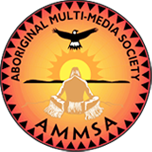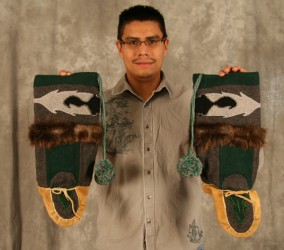Article Origin
Volume
Issue
Year
NAAF winner at Portage College
Vernon Auger, 31, from John D’Or Prairie on the Little Red River Cree Nation, is the recipient of $1,900 from the National Aboriginal Achievement Foundation as part of its bursary and scholarship program. Auger, a Portage College Native Cultural Arts student, sent in photos of his artwork including mukluks and paintings of the Northern Lights as part of his application. “It’s a great honour,” said Auger, who is enrolled in the Native Artisan program this year. “The bursary will go a long way towards paying for my education.” Auger, who took the Native Cultural Arts Instructor stream last year, hopes to return next year to get his Advanced Arts Certificate.
RCMP shootings investigated
On Nov. 30, a man in Driftpile First Nations was shot and killed by a member of the RCMP Emergency Response Team. The fatal shooting followed a standoff in that community when the man emerged from a residence armed. The shooting is now being investigated by Alberta’s Serious Incident Response Team. The name of the victim has not yet been released. In an unrelated matter, ASIRT is also investigating an officer-involved shooting at Alexander First Nation which occurred Nov. 16. The injured First Nations man was airlifted to the University hospital in Edmonton with non-life-threatening injuries.
Alberta chiefs, councilors high salary earners
Documents released by the Canadian Taxpayers Federation show that 82 band chiefs and councilors made more money than the prime minister’s $317,574 salary in 2008-2009. Almost half, 47, reside in Alberta, according to an APTN National News report. Names of individual chiefs and councilors were blacked out in the documents obtained by the CTF. In Atlantic Canada, one reserve politician made $978,000 that year governing in a community of 304 people.
Constable’s funeral attended by hundreds
The funeral of Const. Sheldon Twigg and his wife Kim, daughter Lacey and three-year-old granddaughter Brielle drew 1,500 at Lethbridge’s Exhibition Pavilion. Twigg, a member of the Blood First Nation, was an 18-year officer with the Lethbridge force. Twigg and family members were killed in an accident Nov. 5 when his car collided with a Dodge Ram pickup truck on Hwy. 509 between Stand Off and Lethbridge. Lethbridge Police Chief Tom McKenzie told the Calgary Sun, “The support that came from the First Nations and the surrounding community was fantastic.”
First Nations reps meet with EU members
On Nov. 5, the Indigenous Environmental Network hosted an informal meeting between Members of the European Parliament and elected leadership from First Nations in Alberta and BC to discuss the impact of tar sands development in their communities. The meeting followed a tour of the Athabasca area that the MEP was taken on by federal and provincial representatives. In a news release, Chief Al Lameman of the Beaver Lake Cree Nation, said, “This is about protecting our inherent treaty rights as Indigenous peoples, It was unfortunate that EU Members of Parliament could not meet with First Nations in our homeland earlier in their tour to hear our concerns as true stewards of our lands, instead of only receiving the one-sided propaganda from government and industry.”
Métis Settlements Ombudsman appointed
Harley Johnson will serve again as Métis Settlements Ombudsman taking over from John Brosseau, who resigned abruptly in October after serving only a year. Johnson was appointed Nov. 5 by Aboriginal Affairs Minister Len Webber. Johnson was the first Métis Settlements Ombudsman serving from 2003 to 2007. The MSO, established in 2003 under the authority of the Métis Settlements Act, handles complaints in administrative fairness (how the council, staff, members and other entities deal with each other in their daily business) and conflict of interest (fairness, integrity and impartiality of decision making). There are eight Métis settlements in the province, located primarily in the east-central and northern areas of Alberta.
Alberta NDP approve policy book for Indigenous Peoples
On Nov. 6, in Red Deer, delegates at the Alberta NDP convention unanimously approved an Indigenous Peoples policy book that incorporates the UN Declaration on the Rights of Indigenous Peoples. “This is a landmark first in Canada,” said Lewis Cardinal, co-chair of the Indigenous Peoples caucus of the NDP, in a news release. “This policy document is more comprehensive than what any party offers anywhere in Canada. It will ensure NDP social and economic policy is anchored in the unique relationship of First Nations, Métis, and Inuit in Alberta.” Cardinal is the NDP’s candidate in Edmonton Centre federal riding.
Impact on Fort Chip discussed at US university summit
The impact of tar sands mining on Fort Chipewyan residents was among the topics discussed at the University of Montana in Missoula on Nov. 22 as part of the Tar Sands Resistance Summit. Indigenous Environmental Network volunteer Heather Milton-Lightening highlighted the impact of tar sands mining on the First Nations community of Fort Chip, which is about 150 miles downstream from the Athabasca oil sands. A 2007 study commissioned by the Nunee Health Board Society of Fort Chip found contaminants such as arsenic and mercury are moving downstream and up the local food chain, reported the New West Energy.
Provincial bursaries for health careers awarded
Seventy-four First Nations and Métis students received $436,000 through the provincial government’s Aboriginal Health Careers Bursary. The bursaries range between $3,000 and $11,000 each and are awarded based on academic record, health-career goals, employment prospects, financial need and involvement in the Aboriginal community. The bursary will help create new opportunities for Aboriginal students, said Health and Wellness Minister Gene Zwozdesky. The program, started in 1995 as part of Alberta Health and Wellness Aboriginal Health Strategy and is to help increase the number of Aboriginals working in health care and reduce inequalities. Almost 800 Aboriginal students have received $3.9 million in scholarships since.
LSLIRC receives federal dollars for training
Human Resources and Skills Development federal department is providing over $7 million to the Lesser Slave Lake Indian Regional Council to continue projects designed to deliver job-related programs and services for Aboriginal people in the Lesser Slave Lake area. Through a strong client skills database and an improved partnership with industry, it is expected that participants will find jobs in industries where there are skills shortages. The projects will also create strong partnerships between government, industry, educational and training institutions, and community service providers. These projects are through HRSD’s Aboriginal Skills and Employment Training Strategy, which is part of a government-wide approach to help First Nations, Métis, and Inuit secure sustainable and meaningful employment.
MOU signed by Cold Lake, three First Nations in Saskatchewan
Cold Lake First Nations Chief Cecil Janvier signed a memorandum of understanding with Waterhen Lake First Nation, Canoe Lake Cree First Nation and Buffalo River Dene Nation early last month. The memorandum joins the four First Nations in a commitment to share the benefits of a new business venture into the extraction of oil from the Primrose Lake Air Weapons Range which First Nations groups gained access rights to in 2002. The air weapons range stretches across the border of Alberta and Saskatchewan, and has provided natural resources for First Nations projects for decades. A steering committee will be appointed to oversee the implementation of the goals established by the memorandum. Currently both Canoe Lake First Nation and Cold Lake First Nations hold mineral access rights to the Albertan and Saskatchewan sides of the range, reports the Meadow Lake Progress.
Compiled by Shari Narine
- 2642 views

